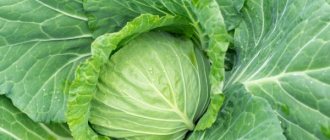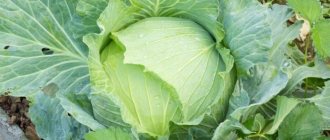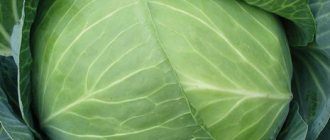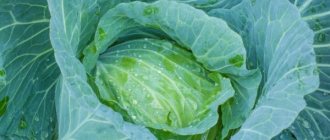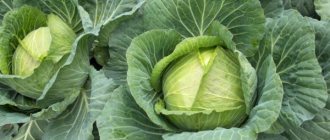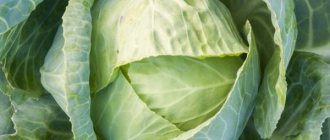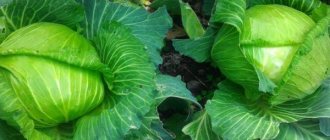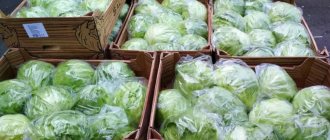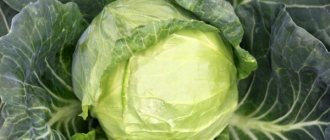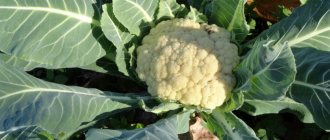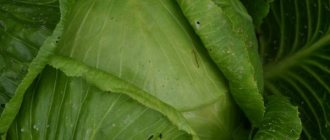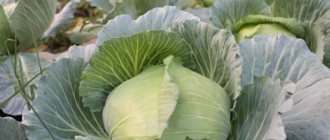Kharkov winter is a late white cabbage variety suitable for long-term storage. It is durable, disease-resistant and not too demanding to care for. Because of these advantages, the variety is often grown by farmers using the heads of cabbage for commercial purposes.
| Landing location | Ripening time | View | Purpose | Origin | Maturation period | Weight |
| Open ground | Late ripening | White cabbage | Fresh, Baby food, Diet food, Long-term storage, Salting, Pickling, Cooking | Variety | 120 | 3 |
History of variety development
Kharkov winter cabbage is a high-yielding variety of Ukrainian selection. The hybrid was bred quite a long time ago - in the mid-70s of the twentieth century, by direct crossing of the Amager 611 and Dauerweiss varieties. Its authors were scientists from the Institute of Vegetable and Melon Growing (Kharkov region, Selectionnoye village).
Learn how to plant and grow cabbage correctly.
The plant is zoned for cultivation in the temperate zone of Ukraine, but it can be grown in almost any climate zone, with the exception of the Far Eastern and Siberian regions.
Diseases and pests
Kharkov cabbage has good immunity. When grown in heavy soil there is a risk of clubroot. The disease manifests itself as swellings and growths on the roots. Affected plants are destroyed and the soil is treated with fluff. Colloidal sulfur is used for prevention.
Because of clubroot, cabbage roots absorb water less well, gradually rot and die.
Kharkov cabbage is resistant to flea beetles and aphids, but is not protected from slugs and snails. For the fight, folk remedies and drugs are used:
- Storm;
- Slug eater;
- Predator;
- Spark.
Traps with beer, kvass, and fermented compote are effective against slugs.
Description and characteristics
Kharkov winter is a representative of high-yielding hybrids of white cabbage. The plant has both the typical characteristics of a cruciferous representative and its own distinctive features.
Description of cabbage heads
During the growing season, this variety of cabbage forms large and dense heads of cabbage with a diameter of 30–40 cm. In the technical ripeness phase, the weight of each of them is 3.5–4 kg. The shape of the forks is round, spherical, and sometimes may be slightly flattened. The leaves fit tightly to each other, the head of cabbage is difficult to separate. The cabbage rosette is quite large, its average diameter is in the range of 80–110 cm. The color of the leaves is predominantly green or pale green, with a light waxy coating appearing on top of the main color.
When cut, the cabbage has a white or cream color, quite dense, not juicy. In the middle of the head of cabbage there is a stalk 10–20 cm long, of medium density. The inner part contains practically no coarse and dense veins, which makes the leaves soft and tender. The harvest has a rich taste, characteristic of representatives of white cabbage hybrids, with a distinct sweetish aftertaste. During processing and grinding, the pulp releases a large amount of juice.
Did you know? Cabbage was first cultivated about 4 thousand years ago. The natural habitat of this plant is considered to be the Mediterranean territory of Africa and Europe, from where the vegetable spread throughout the world.
This cabbage has a high content of the following beneficial substances:
- cellulose;
- vitamin C;
- potassium, zinc and sulfur.
Ripening time
This plant belongs to late-ripening vegetable crops. From sowing seeds for seedlings to harvesting mature heads of cabbage, it takes about 150–170 days.
Frost resistance of the variety
The hybrid has fairly high frost resistance. Despite the fact that this cabbage requires a lot of heat for growth and fruiting, the seedlings are able to successfully withstand short frosts down to –2°C.
Harvest and storage
The harvest is harvested 150-170 days after emergence on a clear and dry day. In a temperate climate this is mid-September or the second half of October. It is advisable to arrive before frost, since, despite the frost resistance of the variety, prolonged exposure to low temperatures leads to rotting of the heads of cabbage during storage.
Reference. There is no need to rush into harvesting – the heads of cabbage of this variety do not crack, even if they remain in the beds for a long time.
The collected heads of cabbage are carefully inspected and sorted, removing cabbage debris and setting aside small non-standard specimens for prompt consumption. After this, the crop is laid out under a canopy and left to dry for about 5 hours. If you leave cabbage in the sun, it will begin to wilt.
Store the harvest in a dark, cool (0...+2°C) place with good ventilation and air humidity of 85-95% for six months. To increase the shelf life, the heads of cabbage are pulled out from the beds, rather than cut, and then hung by the stalk, head down.
Pros and cons of the variety
- The main advantages of this cabbage hybrid are:
- good shelf life and transportability;
- large size of heads of cabbage;
- drought resistance and unpretentiousness;
- resistance to characteristic infections;
- resistance to cracking of mature heads of cabbage;
- versatility of the crop - the vegetable is suitable for fresh consumption, as well as all kinds of processing;
- cabbage does not spoil if harvested late.
No serious shortcomings were identified in the Kharkov winter one. The only exception is the variety’s need for painstaking care.
What kind of variety is this
Kharkov winter is a white cabbage bred by Ukrainian breeders of the Research Institute of Vegetable and Melon Growing as a result of crossing the varieties Amager 611 and Dauerweiss.
Growing girl's grapes on the balcony. Recommendations for growing virgin grapes on the balcony. New from users
The variety was approved for use in Russia (with the exception of the Northern, East Siberian and Far Eastern regions) in 1976.
Description and characteristics
The variety is distinguished by late ripening - 150-170 days pass from mass germination to technical maturity of heads of cabbage. Marketable yield – 11-12 kg/sq.m. m.
Kharkov winter without problems tolerates an increase in air temperature up to +40°C and a drop to -3°C, so it is not afraid of the first autumn and return spring frosts. Cabbage easily tolerates lack of moisture - drought does not negatively affect yield, taste and marketability.
Consumer qualities
The variety is characterized by round or slightly flattened, dense, medium-sized heads of cabbage, the diameter of which is 30-40 cm, and the weight varies from 2.7 to 4.7 kg.
The covering leaves are white-green with a bluish tint, smooth or slightly wrinkled, covered with a waxy coating. They fit tightly to the head of cabbage and protect the forks from heat or frost. When cut, the heads of cabbage are mostly white, but in the center it turns into cream, and the parts adjacent to the covering leaves may be greenish. The stalk reaches a length of 15-20 cm, while being quite thin. There are no hard veins or leaf bases inside the heads of cabbage.
The variety is distinguished by its sweet taste, high sugar content, juiciness and pronounced cabbage aroma of leaves. Kharkov winter contains a lot of vitamin C, fiber and microelements, including potassium, sulfur and zinc. The variety produces virtually no waste - approximately 93% of the vegetable is consumed.
Cabbage of this variety is consumed fresh, fermented, used for preparing salads and hot dishes, stewed and included in the filling for pies, as well as canned, pickled and pickled.
Growing seedlings
Despite the unpretentiousness and resistance of this cabbage to cold weather, its cultivation is considered a labor-intensive agrotechnical procedure. The plant requires comprehensive care, as well as daily attention throughout the season - otherwise the heads of cabbage will not be able to fully ripen, and their quality will not reach the average statistical norm.
Did you know? Cabbage was one of the main medicinal plants used by the famous ancient physician Hippocrates. Its leaves and various extracts from it were used to combat and prevent a whole range of ailments, as well as as the main means of maintaining vitality.
Deadlines
The optimal time for sowing the variety for seedlings is approximately 50 days before the expected date of planting young plants in open soil. In the temperate zone, the best time for this is considered to be the beginning of April. This makes it possible to obtain active and healthy plants at the time of transplanting seedlings.
Soil selection and preparation
Cabbage loves fertile and loose soils, with a moderate ratio of organic and mineral substances, characterized by a neutral pH value (6.5–7). Specialized substrates from garden stores are best suited for this. You can prepare the soil yourself; to do this, mix peat, river sand and turf soil in equal parts.
Be sure to add 1 tbsp to the resulting mixture per 10 liters. spoon of dolomite flour and superphosphate, as well as 2 tbsp. spoons of wood ash. Prepare the soil in advance, as it requires sterilization.
Read more about the benefits and harms of cabbage.
The procedure is carried out a week before sowing the seeds; for this, the soil of your choice is necessary:
- fry in the oven at +125°C for 25 minutes;
- soak with a 2% solution of potassium permanganate;
- keep in the freezer at –25°C for about 3 days.
Calcination of the soil in the oven.
Seed treatment before sowing
Seeds also need preparation, otherwise there is a danger of young sprouts being damaged by bacterial, viral or fungal infections. To do this, the seed material is optionally soaked in 70% alcohol (5–10 minutes) or in a 2% solution of potassium permanganate (30 minutes).
Before planting, the seeds need to be activated. To do this, they are dipped for 20 minutes in warm water with a temperature of about +50°C, and then laid out on a plate and covered with a thin natural fabric in 1 layer. After this, the seeds should be kept in the refrigerator at a temperature of about +5°C for 12 hours.
You will be interested to know what are the features of planting cabbage before winter.
Also, soaking in special growth stimulants will help improve the germination of seed. To do this, the seeds are additionally dipped into a solution of the drug “Sodium Humate” or “Ideal” (optional). The procedure is carried out for 12 hours at room temperature. To prepare the working fluid, dissolve 1 teaspoon of the product in 1 liter of water.
Sizing is an important process for selecting large, viable seeds. Soak them in a 5% solution of table salt for 5 minutes. Those that do not sprout will float.
Seedling care
For crops, it is necessary to create standard care conditions:
- Keep containers in a well-lit and warm place at a temperature of +22…+25°C.
- Water the seedlings moderately and regularly. Add water in small portions, avoiding waterlogging and drying out of the substrate.
- Feed the crops twice: first after full germination, then repeat after 2 weeks. A concentrated solution of cow manure (1:4) is best suited for feeding.
- Containers must be illuminated - daylight hours must be at least 12 hours a day.
Important! 1 week before transplanting, watering the seedlings should be stopped - this will improve the rooting of cabbage in the new substrate.
Transplanting seedlings to a permanent place
The most important step in growing cabbage is transplanting young seedlings into the garden bed. The quality of rooting and fruiting of cabbage depends on the correctness and consistency of all operations during this period.
Transplant timing
Depending on the sowing date, Kharkov winter planting is carried out from the middle to the end of May. By this point, stable warm weather should arrive, and the seedlings should produce at least 5 leaves.
Selecting a location
The best soil for growing vegetables is considered to be substrates with high or medium moisture capacity. Areas with well-fertilized loamy soils with a neutral pH are ideal for this. In their absence, the soil must be prepared; for this, 3 buckets of sand, 1 bucket of humus, 1 kg of dolomite flour or chalk should be added per 1 m² of land.
Important! It is best to grow cabbage after tomatoes, carrots or peas. Any representatives of cruciferous vegetables, including turnips and radishes, are considered bad predecessors.
The area of the beds should be located on a hill or plain. It is not recommended to plant cabbage in lowlands - this will lead to increased humidity in the beds and the appearance of putrefactive lesions. Also, the plant does not tolerate prolonged exposure to direct sunlight, so it is best to place the beds in partial shade. Ideally suited for this will be proximity to tall vegetation and garden buildings.
Planting pattern and depth
Cabbage seedlings are planted in rows, with a row spacing of 60–70 cm and a distance between neighboring plants in a row of about 35–40 cm. The planting depth should be within 5–10 cm.
Cabbage planting scheme. If the vegetable is grown in an open and well-lit area, it is necessary to plant tall crops that create moderate shading every 5–10 rows. Corn or sunflower are best suited for this.
Advantages and disadvantages of cabbage
Cabbage has a lot of advantages, thanks to which it has become widespread not only in its native country, but also abroad. Among the main advantages of a farmer are:
- High yield. From 1 m2 you can easily harvest up to 11 kg of cabbage. The harvested crop will be distinguished by high density of ears and good taste.
- The harvest ripens at the same time, which is a huge plus for commercial cultivation of the crop.
- Due to the high density of heads of cabbage, they are easily transported over long distances without loss of commercial quality.
- Cabbage does not suffer from lack of moisture. Naturally, you shouldn’t expect an excellent harvest without watering, but if the humidity level in the area is slightly below normal, then there will be no serious problems with Kharkovskaya.
- It genetically has high protection against pests and various cabbage diseases. In particular, this variety is not prone to spot necrosis and mucous bacteriosis.
- The culture has fairly good frost resistance. It tolerates temperature drops down to -1-2 degrees Celsius.
- In addition to frost resistance, it has good heat resistance. It can withstand temperatures up to 40 degrees Celsius.
- Even after full ripening, the heads of cabbage can remain on the stump for a long time without cracking or losing their taste.
As for the negative qualities of the Kharkov winter, no significant shortcomings were noticed on the part of the farmers.
Valentina Ivanovna, Kyiv, 43 years old.
But I am a true patriot of Kharkov. We usually praise, and not only here, varieties of Dutch selection, but also Japanese ones have begun to appear. But I still like Kharkovskaya the most among the later ones. It is adapted to the climatic conditions of Ukraine, and the taste is excellent. In addition, you can ferment. The taste is good.
Read more: Grapes ruby anniversary description of variety photo reviews
Igor Ivanovich, Moscow, 52 years old.
The Kharkovskaya variety is late-ripening. During cultivation, the temperature dropped to -4 degrees Celsius, and the cabbage held up well. The leaves are medium-sized, very heavily covered with a waxy coating. The originator states that the shape of the head of cabbage is flat, but mine grew oval-round. The head of cabbage itself is very dense and heavy; the maximum weight of my heads of cabbage reached 4.2 kg.
There is a rather long poker inside. The taste is good. My wife made salads from Kharkov, made borscht, and stewed it into pies. There are no complaints, the cabbage is really good. It lay there all winter, until February. I’m sure there would have been more, but they would have eaten it all. This year we will also grow Kharkovskaya.
Kharkov winter cabbage has a lot of advantages, thanks to which it has become widespread not only in its native country, but also abroad. Among the main advantages of a farmer are:
- High yield. From 1 m2 you can easily harvest up to 11 kg of cabbage. The harvested crop will be distinguished by high density of ears and good taste.
- The harvest ripens at the same time, which is a huge plus for commercial cultivation of the crop.
- Due to the high density of heads of cabbage, they are easily transported over long distances without loss of commercial quality.
- Cabbage does not suffer from lack of moisture. Naturally, you shouldn’t expect an excellent harvest without watering, but if the humidity level in the area is slightly below normal, then there will be no serious problems with Kharkovskaya.
- It genetically has high protection against pests and various cabbage diseases. In particular, this variety is not prone to spot necrosis and mucous bacteriosis.
- The culture has fairly good frost resistance. It tolerates temperature drops down to -1-2 degrees Celsius.
- In addition to frost resistance, it has good heat resistance. It can withstand temperatures up to 40 degrees Celsius.
- Even after full ripening, the heads of cabbage can remain on the stump for a long time without cracking or losing their taste.
Planting care
Kharkov winter cabbage requires the usual care measures throughout the entire growing season. They provide for timely pest control, watering, fertilizing and soil cultivation.
We recommend that you find out why cabbage leaves turn yellow.
Watering and fertilizers
Water the cabbage every 5–6 days; in dry and hot weather, the frequency of the procedure is increased. The water must be purified and heated to ambient temperature. For the first 2–3 days, the watering rate should be about 6 l/m², then gradually increase it to 10–12 l/m².
In addition to watering, cabbage requires up to 4 feedings throughout the growing season:
- The first time is 2 weeks after planting. Solutions of cow manure (0.5 liters of manure / 10 liters of water), with a consumption of 0.5 liters per plant, are best suited for this.
- The next feeding is 4 weeks after planting the cabbage. For this, they also use a solution of 0.5 liters of manure per 10 liters of water, at the rate of 0.5 liters per plant.
- The third time the beds are fed after 6 weeks with saturated phosphorus fertilizers. To do this, dilute 1 tbsp in 10 liters of water. a spoonful of nitrophoska. The working fluid consumption is 6–8 l/m².
- The last feeding is in the 9th week after planting the seedlings in open soil. To do this, use a solution of nitrophoska or cow manure.
Soil care
Weeding and loosening are considered mandatory when caring for cabbage plantings. They allow you to saturate the substrate with oxygen, and also avoid the influence of weeds on the cabbage. Both procedures are often carried out together, which simplifies the overall care of the beds. The soil must be completely loosened to a depth of about 5–7 cm, while weeds and their remains must be removed from the soil.
Find out why cabbage rots on the vine.
The frequency of the procedure depends on watering, since weeding is done the next day after the area is moistened, but at least once a week. Hilling cabbage is not considered a mandatory measure, however, this procedure helps protect the plants from pests and also avoid the heads of cabbage from lying down during ripening.
Hilling is done twice, on the 10th and 40–50th days after planting, in dry and windless weather. Late evening is best for this, which helps to avoid drying out of the substrate. Hilling is carried out in such a way as to pull the maximum amount of soil under the stem of the bush within a radius of 20–30 cm around each trunk. In this case, you need to form a rounded hill about 30 cm high around the cabbage.
Pest and disease control
Kharkov winter is characterized by increased resistance to major infections of cruciferous crops, including bacteriosis and necrosis, so this problem occurs infrequently. To combat various ailments, complex protective agents are used.
The drugs that performed best were:
- "Fitoverm";
- "Inta-Vir";
- "Decis";
- "Spark".
Powerful contact preparations will save you from all kinds of pests on your site.
Did you know? Cabbage entered the territory of Rus' in the 5th century, and the Greek colonies of the Black Sea region became the center of its distribution.
Today there is a large selection of such products on the market, but the most effective are:
- “Herold”, “Aliot”, “Shar Pei”, “Senpai” - against caterpillars, aphids, cabbage flea beetles;
- “Fly-eater”, “Terradox” - eliminate cabbage fly and its larvae;
- "Miura" is the best protective agent against grass weeds.
The main threat to cabbage plantings is slugs. They love to live in cool and damp corners of the site, which are precisely the best place to grow vegetables. It is not easy to overcome slugs, since they instantly infect cabbage and quite often, feeding on its leaves, lead to the death of the plantings, especially in the early stages of development.
Slugs on cabbage. The best remedy for these pests is a mixture of equal parts of table salt, ground black pepper and mustard powder. The area of the beds, as well as the surrounding area, is generously sprinkled with it.
Kharkov cabbage variety description
Purpose of the variety: universal Head shape round-flat Head color green Rosette diameter 80 – 110 cm Head weight 1.9 – 3.5 kg Maturing period 150 – 160 days Productivity per square meter 10 – 11 kg Frost resistance up to -1 – -2 degrees Heat resistance up to 40 degrees
• High-yielding variety. From one square meter of plantings you can collect 10-11 kg of cobs. They are characterized by high density and excellent taste. All welks ripen at the same time. • The variety tolerates long-term transportation well, so it is often grown for commercial purposes. • Can be cultivated in insufficiently moist areas. Lack of moisture does not affect the qualitative and quantitative indicators of the crop. • The characteristics of the variety indicate that its branches are round-flat in shape, green in color and do not crack even when left on the site for a long time in a ripe form. Each of them weighs from 1.9 to 3.5 kilograms. • Resistance to pests and diseases is high. Heads of Kharkov cabbage are not afraid of point necrosis and mucous bacteriosis. • Frost resistance is average. When the temperature drops at night to -1 - -2 degrees during the growth period, the plant is not damaged. • This late cabbage has excellent heat resistance, tolerating air temperatures up to 40 degrees. • It is not necessary to harvest the crop immediately after ripening. Velki can remain in the garden almost until winter. At the same time, the cabbage remains just as tasty and does not spoil.
